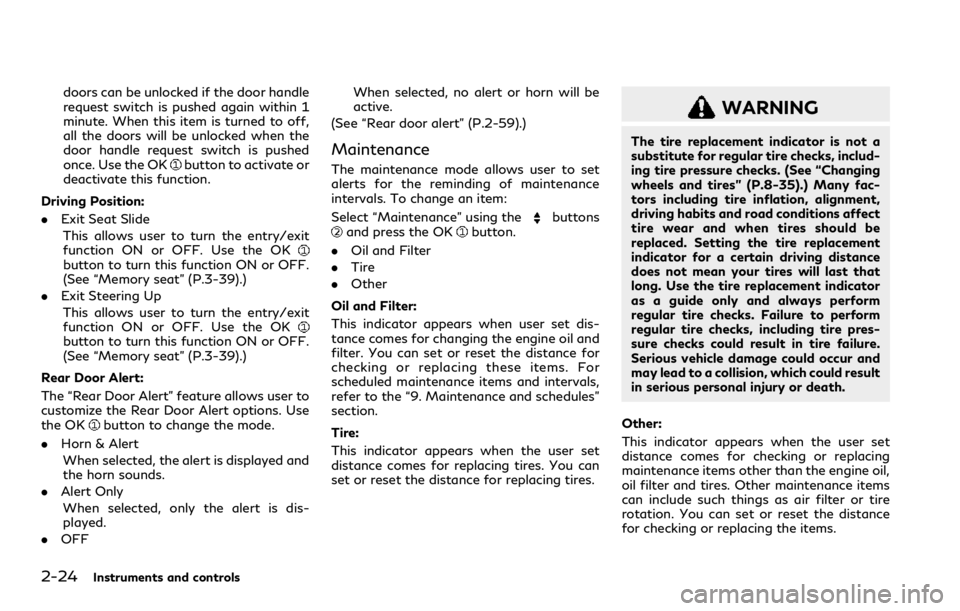seat memory INFINITI QX80 2023 Owners Manual
[x] Cancel search | Manufacturer: INFINITI, Model Year: 2023, Model line: QX80, Model: INFINITI QX80 2023Pages: 590, PDF Size: 2.57 MB
Page 16 of 590

0-6Illustrated table of contents
WAA0353X
1. Cargo light (P.2-81)
2. Cup holders (3rd row seat) (P.2-68)
3. Rear ventilators (P.4-27)
4. Coat hooks (P.2-71)
5. Rear personal lights (P.2-79)
6. Door armrest— Power window controls (P.2-73)
— Power door lock switch (P.3-5)
— Outside rearview mirror remote con-
trol switch (driver’s side) (P.3-37)
7. Memory seat (P.3-39)
8. Sun visors (P.3-29) 9. Map lights (P.2-79)
10. Moonroof switch (P.2-76)
11. E-Call (SOS) button (if so equipped)
(P.2-65)
12. Sunglasses holder (P.2-68)
13. Inside rearview mirror (P.3-30) — Smart Rearview Mirror (if so
equipped) (P.3-31)
— HomeLink
®universal transceiver
(P.2-81, P.2-85)
14. Cargo area — Power outlet (P.2-60)
— Cargo floor box (P.2-72)
— Luggage hooks (P.2-71)
— Jacking tools (P.6-5)
15. Rear console box (P.2-70) — Cup holders (2nd row seat) (if so
equipped) (P.2-66)
— Pocket (if so equipped) (P.2-70)
16. Cup holders (2nd row seat) (if so equipped) (P.2-66)
17. Rear Seat Infotainment (RSI) system (if so equipped) (P. 4-37)
18. Console box (P.2-70) — Power outlet (P.2-60)
— USB charging connector (P.2-62)
— Rear Media Interface
PASSENGER COMPARTMENT
Page 28 of 590

1-4Safety — seats, seat belts and supplemental restraint system
FRONT SEATS
Front power seat adjustment
Operating tips:
.The power seat motor has an auto-reset
overload protection circuit. If the motor
stops during operation, wait 30 seconds,
then reactivate the switch.
. Do not operate the power seat switch for
a long period of time when the engine is
off. This will discharge the battery.
See “Memory seat” (P.3-39) for the seat
position memory function.
CAUTION
When adjusting the seat positions, be
sure not to contact any moving parts to
avoid possible injuries and/or damages.
SSS1051
Forward and backward:
Moving the switch
forward or backward
will slide the seat forward or backward to
the desired position.
Reclining:
Move the recline switch
backward until
the desired angle is obtained. To bring the
seatback forward again, move the switch
forward.
The reclining feature allows adjustment of
the seatback for occupants of different sizes
for added comfort and to help obtain proper
seat belt fit. (See “Precautions on seat belt
usage” (P.1-18).) Also, the seatback can be
reclined to allow occupants to rest when the vehicle is stopped and the transmission is in
the P (Park) position.
Page 120 of 590

2-24Instruments and controls
doors can be unlocked if the door handle
request switch is pushed again within 1
minute. When this item is turned to off,
all the doors will be unlocked when the
door handle request switch is pushed
once. Use the OK
button to activate or
deactivate this function.
Driving Position:
. Exit Seat Slide
This allows user to turn the entry/exit
function ON or OFF. Use the OK
button to turn this function ON or OFF.
(See “Memory seat” (P.3-39).)
. Exit Steering Up
This allows user to turn the entry/exit
function ON or OFF. Use the OK
button to turn this function ON or OFF.
(See “Memory seat” (P.3-39).)
Rear Door Alert:
The “Rear Door Alert” feature allows user to
customize the Rear Door Alert options. Use
the OK
button to change the mode.
. Horn & Alert
When selected, the alert is displayed and
the horn sounds.
. Alert Only
When selected, only the alert is dis-
played.
. OFF When selected, no alert or horn will be
active.
(See “Rear door alert” (P.2-59).)
Maintenance
The maintenance mode allows user to set
alerts for the reminding of maintenance
intervals. To change an item:
Select “Maintenance” using the
buttonsand press the OKbutton.
. Oil and Filter
. Tire
. Other
Oil and Filter:
This indicator appears when user set dis-
tance comes for changing the engine oil and
filter. You can set or reset the distance for
checking or replacing these items. For
scheduled maintenance items and intervals,
refer to the “9. Maintenance and schedules”
section.
Tire:
This indicator appears when the user set
distance comes for replacing tires. You can
set or reset the distance for replacing tires.
WARNING
The tire replacement indicator is not a
substitute for regular tire checks, includ-
ing tire pressure checks. (See “Changing
wheels and tires” (P.8-35).) Many fac-
tors including tire inflation, alignment,
driving habits and road conditions affect
tire wear and when tires should be
replaced. Setting the tire replacement
indicator for a certain driving distance
does not mean your tires will last that
long. Use the tire replacement indicator
as a guide only and always perform
regular tire checks. Failure to perform
regular tire checks, including tire pres-
sure checks could result in tire failure.
Serious vehicle damage could occur and
may lead to a collision, which could result
in serious personal injury or death.
Other:
This indicator appears when the user set
distance comes for checking or replacing
maintenance items other than the engine oil,
oil filter and tires. Other maintenance items
can include such things as air filter or tire
rotation. You can set or reset the distance
for checking or replacing the items.
Page 159 of 590

WIRELESS CHARGER (if so
equipped)
The wireless charger is located inside the lid.
Push the lid release button up to open the lid.
Place the smartphone on the pad of the
wireless charger with screen face up. Char-
ging will start automatically. The smart-
phone will be charged continuously while
the ignition switch is in the ON position.
NOTE:
The wireless charger requires the vehicle
doors to be closed before charging will
start. If the doors are opened, the charging
function will not operate.
WARNING
.Never put metallic materials between
the wireless charger and a smart-
phone.
. Those who use a pacemaker or other
medical equipment should contact
the electric medical equipment man-
ufacturer for the possible influences
before use.
. Never put cloth over the smartphone
during charging process.
. Never charge a smartphone when it is
wet. .
Never put metallic materials or small
goods such as a cigarette lighter,
Intelligent Key or memory drive.
CAUTION
.Do not put an RFID/NFC/credit card
between the wireless charger and a
smartphone. This could cause data
corruption in the card.
. Do not use the wireless charger with
dust accumulated or dirt on the pad.
. Do not hit the surface of the wireless
charger.
. Do not spill liquid (water, drinks, etc.)
on the charging pad.
. Do not use grease, oil or alcohol for
cleaning charging pad.
Wireless charger Indicator
The indicatorwill illuminate in orange
when the charging process is started.
When the charging has completed, the
indicator illuminates in green.
If a malfunction occurs or the charging
process has stopped, the indicator will blink
in orange for 8 seconds then turn off.
Operation of the wireless charger
To use the wireless charger, it is necessary to
properly position the smartphone on the
charging pad with the screen facing up. To
maximize charging performance, ensure the
smartphone is fully seated on the center of
the charging pad over the
logo.
Because the location of the power receiver
may vary depending on the smartphone, you
will need to try and find the area that suits
your smartphone.
Because some smartphone cases or acces-
sories may adversely affect charging, re-
move them before wireless charging.
Turn off the vibration function of the
smartphone before wireless charging.
NOTE:
. Only a Qi compatible smartphone can be
used.
. The smartphone or the wireless charger
may be warmed during charging process
and the charging may stop by the
protection function of the smartphone
or the wireless charger. This is not a
malfunction. If this occurs, restart char-
ging after the smartphone or the wire-
less charger cooled down. The indicator
will blink in orange then turn off.
. The wireless charging process may be
stopped by the status of the smart-
Instruments and controls2-63
Page 189 of 590

3 Pre-driving checks and adjustments
Keys ........................................................................\
.............. 3-2Intelligent Key .............................................................. 3-2
Valet hand-off ............................................................. 3-4
Doors ........................................................................\
............ 3-4 Locking with mechanical key ................................... 3-4
Opening and closing windows with the
mechanical key ............................................................. 3-5
Locking with inside lock knob ................................. 3-5
Locking with power door lock switch ................... 3-5
Automatic door locks ................................................. 3-6
Child safety rear door lock ...................................... 3-6
Intelligent Key system ...................................................... 3-7 Intelligent Key operating range ............................... 3-9
Door locks/unlocks precaution ............................... 3-9
Intelligent Key operation ......................................... 3-10
Battery saver system ............................................... 3-12
Warning signals ......................................................... 3-12
Troubleshooting guide ............................................. 3-13
Remote keyless entry system ...................................... 3-15 How to use remote keyless entry system .......... 3-16
Remote engine start (if so equipped) ........................ 3-19 Remote engine start operating range ................. 3-19
Remote starting the engine ................................... 3-19
Extending engine run time ..................................... 3-20 Canceling a remote engine start ........................ 3-20
Conditions the remote engine start will
not work ................................................................... 3-20
Hood ........................................................................\
.......... 3-21
Liftgate ........................................................................\
..... 3-22 Operating manual liftgate .................................... 3-22
Operating power liftgate ...................................... 3-22
Auto closure ............................................................ 3-25
Liftgate release lever ............................................. 3-26
Fuel-filler door ................................................................ 3-26
Opening the fuel-filler door ................................. 3-26
Fuel-filler cap ........................................................... 3-26
Tilt/telescopic steering ................................................. 3-29
Electric operation .................................................... 3-29
Sun visors ........................................................................\
. 3-29
Mirrors ........................................................................\
..... 3-30
Inside mirror ............................................................. 3-30
Outside mirrors ........................................................ 3-37
Vanity mirror ............................................................ 3-39
Memory seat ................................................................... 3-39
Entry/exit function ................................................. 3-39
Memory storage ..................................................... 3-40
Setting memory function ...................................... 3-41
System operation .................................................... 3-41
Page 217 of 590

WARNING
.Do not adjust the steering wheel
while driving. You could lose control
of your vehicle and cause an accident.
. Do not adjust the steering wheel any
closer to you than is necessary for
proper steering operation and com-
fort. The driver’s air bag inflates with
great force. If you are unrestrained,
leaning forward, sitting sideways or
out of position in any way, you are at
greater risk of injury or death in a
crash. You may also receive serious or
fatal injuries from the air bag if you
are up against it when it inflates.
Always sit back against the seatback
and as far away as practical from the
steering wheel. Always use the seat
belts.
SPA2754
ELECTRIC OPERATION
Tilt or telescopic operation
Move the leverto adjust the steering
wheel up or down, forward or rearward to
the desired position.
Entry/Exit function operation:
The memory seat system will make the
steering wheel move up automatically when
the driver’s door is opened with the ignition
switch in the LOCK position. This lets the
driver get into and out of the seat more
easily.
For more information, see “Memory seat”
(P.3-39).
SIC3451
Pre-driving checks and adjustments3-29
TILT/TELESCOPIC STEERING SUN VISORS
Page 227 of 590

SIC4448
VANITY MIRROR
To use the front vanity mirror, pull down the
sun visor and pull up the cover.
JVP0250X
SET/memory switches
The memory seat system has three features:
. Entry/exit function
. Memory storage
. Setting memory function
ENTRY/EXIT FUNCTION
This system is designed so that the driver’s
seat and steering column will automatically
move when the automatic transmission shift
lever is in the P (Park) position. This allows
the driver to get into and out of the driver’s
seat more easily.
The driver’s seat will slide backward and the
steering wheel will move up when the
driver’s door is opened with the ignition switch in the LOCK position.
The driver’s seat and steering wheel will
return to the previous positions when the
ignition switch is pushed to the ACC posi-
tion.
The driver’s seat will not return to the
previous positions if the seat or steering
adjusting switch is operated when the seat is
at the exit position.
Cancel or activate entry/exit func-
tion
The shift lever must be in the P (Park)
position with the ignition switch in the OFF
position.
The entry/exit function can be activated or
canceled by pressing and holding the SET
switch for more than 10 seconds.
The entry/exit function can be canceled
through “Vehicle settings” in the vehicle
information display by performing the fol-
lowing:
.
Switch the “Exit Seat Slide” ON to OFF.
For additional information, refer to “Ve-
hicle settings” (P.2-23).
. Switch the “Exit Steering Up” ON to OFF.
For additional information, refer to “Ve-
hicle settings” (P.2-23).
Pre-driving checks and adjustments3-39
MEMORY SEAT
Page 228 of 590

3-40Pre-driving checks and adjustments
Initialize entry/exit function
If the battery cable is disconnected, or if the
fuse opens, the entry/exit function will not
work though this function was set on before.
In such a case, after connecting the battery
or replacing with a new fuse, open and close
the driver’s door more than two times after
the ignition switch is turned from the ON
position to the LOCK position. The entry/
exit function will be activated.
MEMORY STORAGE
Two positions for the driver’s seat, steering
column and outside mirrors can be stored in
the memory switch. Follow these procedures
to use the memory system.
1. Move the shift lever to the P (Park)position.
2. Adjust the driver’s seat, steering column and outside mirrors to the desired posi-
tions by manually operating each adjust-
ing switch. For additional information,
see “Seats” (P.1-3) and “Tilt/telescopic
steering” (P.3-29) and “Outside mirrors”
(P.3-37).
3. Push the SET switch and, within 5 seconds, push the memory switch (1 or
2) fully for at least 1 second.
The indicator light for the pushed mem-
ory switch will stay on for approximately 5 seconds after pushing the switch.
When the memory is stored in the
memory switch (1 or 2), a buzzer will
sound.
If memory is stored in the same memory
switch, the previous memory will be
deleted.
Linking Intelligent Key to a stored
memory position
The Intelligent Key can be linked to a stored
memory position with the following proce-
dure.
1. Follow the steps for storing a memory
position.
2. While the indicator light for the memory switch being set is illuminated for 5
seconds, push the
button on the
Intelligent Key. If the indicator light
blinks, the Intelligent Key is linked to
that memory setting.
Push the ignition switch to the OFF position,
and then push the
button on the
Intelligent Key. The driver’s seat, steering
wheel and outside mirrors will move to the
memorized position.
Confirming memory storage
. Push the ignition switch to the ON
position and push the SET switch. If the
main memory has not been stored, the
indicator light will come on for approxi-
mately 0.5 second. When the memory
has stored in position, the indicator light
will stay on for approximately 5 seconds.
. If the battery cable is disconnected, or if
the fuse opens, the memory will be
canceled. In this case, reset the desired
position using the previous procedure.
. If optional Intelligent Keys are added to
your vehicle, the memory storage proce-
dure to switch 1 or 2 and linking
Intelligent Key procedure to a stored
memory position should be performed
again for each Intelligent Key. For addi-
tional Intelligent Key information, see
“Keys” (P.3-2).
Selecting the memorized position
1. Move the shift lever to the P (Park) position.
2. Use one of the following methods to move the driver’s seat, the outside
mirrors and the steering wheel.
.Push the memory switch (1 or 2) fully
for at least 1 second.
The driver’s seat, steering column and
outside mirrors will move to the memor-
Page 229 of 590

ized position or to the exit position when
the entry/exit function is set to active
with the indicator light flashing, and then
the light will stay on for approximately 5
seconds.
SETTING MEMORY FUNCTION
The status of the following settings can be
linked to the Intelligent Key and the memor-
ized settings can be available for each
Intelligent Key.
.Air conditioner system
. Navigation system
. Audio system
To use the memory function, lock the doors
with the Intelligent Key that is linked to the
settings.
To enable the memorized settings:
1. Carry the Intelligent Key that is linked to the settings, and unlock the doors by
pushing the driver’s door handle request
switch or “UNLOCK”
button on the
Intelligent Key.
2. Place the ignition switch in the ON position. The memorized settings are
available.
SYSTEM OPERATION
The memory seat system will not work or
will stop operating under the following
conditions:
.When the vehicle speed is above 0 MPH
(0 km/h) or 4 MPH (7 km/h) for some
limited functions such linking an Intelli-
gent Key to the vehicle when the power
source is turned on from off or during the
Exit function.
. When any of the memory switches are
pushed while the memory seat is operat-
ing.
. When the adjusting switch for the dri-
ver’s seat and steering column is turned
on while the memory seat is operating.
. When the seat has already been moved
to the memorized position.
. When no seat position is stored in the
memory switch.
. When the shift lever is moved from the P
(Park) position to any other position.
Pre-driving checks and adjustments3-41
Page 577 of 590

If your vehicle overheats ............................. 6-14
Oil pressure gauge .......................................... 2-9
Protection mode ............................................ 5-17
Starting the engine ....................................... 5-15
Entry/exit function, memory seat .................. 3-39
Event Data Recorders (EDR) ........................ 10-35
Exhaust gas (carbon monoxide) ........................ 5-4
Explanation of scheduled
maintenance items ................................................. 9-5
Extended storage switch .................................. 8-20
F
F.M.V.S.S./C.M.V.S.S. certification label .... 10-12
Filter Air cleaner housing filter ............................. 8-14
Changing engine oil and filter ...................... 8-6
Flashers (See hazard warning
flasher switch) ......................................................... 6-2
Flat tire ...................................................................... 6-3
Flat towing .......................................................... 10-31
Flexible seating ..................................................... 1-11
Floor mat cleaning ................................................. 7-6
Fluid Automatic Transmission Fluid (ATF) ......... 8-8
Brake fluid ......................................................... 8-9
Capacities and
recommended fluids/lubricants ................. 10-2
Engine coolant .................................................. 8-4
Engine oil ........................................................... 8-6
Power steering fluid ....................................... 8-8
Window washer fluid .................................. 8-10 Fog light switch ................................................... 2-52
Forward Emergency Braking (FEB) with
Pedestrian Detection system ........................... 5-95
Forward Emergency Braking system
warning light ......................................................... 2-16
Front and rear sonar system .......................... 5-126
Front passenger air bag and status light ..... 1-59
Front power seat adjustment ............................. 1-4
Front seat
Front seat adjustment ........................ 1-4, 1-10
Front-seat active head restraint ...................... 1-17
Fuel Capacities and
recommended fluids/lubricants ................. 10-2
Fuel economy ............................................... 5-116
Fuel information ........................................... 10-4
Fuel octane rating ........................................ 10-4
Fuel-filler cap .................................................. 3-26
Fuel-filler door ............................................... 3-26
Gauge .................................................................. 2-9
Loose Fuel Cap warning ............................. 3-28
Fuel efficient driving tips ................................. 5-115
Fuses ....................................................................... 8-18
Fusible links ........................................................... 8-19
G
Garage door opener
HomeLink®
Universal Transceiver ....................... 2-81, 2-85
Gas cap ................................................................... 3-26 Gauge ........................................................................\
. 2-6
Engine coolant temperature gauge ............ 2-8
Engine oil pressure gauge ............................. 2-9
Fuel gauge ......................................................... 2-9
Odometer ............................................................ 2-7
Speedometer ...................................................... 2-7
Tachometer ....................................................... 2-8
Trip computer ................................................. 2-35
General maintenance ............................................. 9-2
Glove box ............................................................... 2-69
H
Hazard warning flasher switch ........................... 6-2
Head restraints/headrests ................................ 1-13
Headlight washer ................................................ 2-50
Headlights Aiming control ................................................ 2-49
Aiming control (See adaptive front
lighting system (AFS)) ................................. 2-50
Bulb replacement .......................................... 8-24
Headlight switch ........................................... 2-44
Heated seats ......................................................... 2-54
Heated steering wheel ....................................... 2-53
Heater Automatic climate control ......................... 4-28
Engine block heater ................................... 5-138
High beam assist ................................................. 2-47
Hill start assist system ..................................... 5-123
HomeLink
®Universal Transceiver ...... 2-81, 2-85
Hood release ......................................................... 3-21
11-3